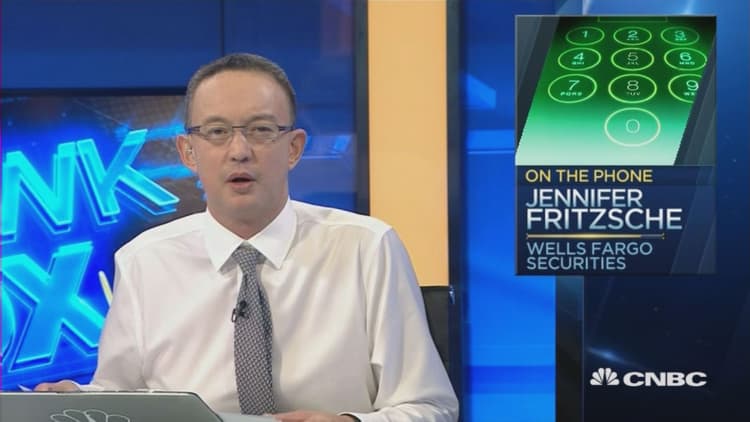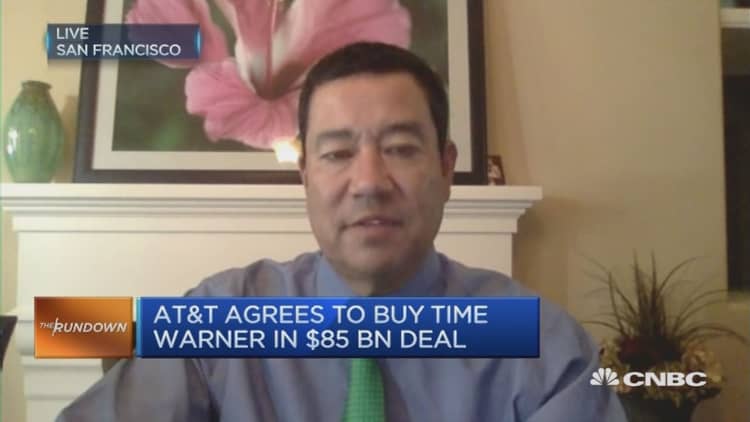


AT&T will need to emphasize consumer demand, and continued healthy competition, to get its blockbuster acquisition of Time Warner past regulators, a Wells Fargo analyst told CNBC.
Jennifer Fritzsche, managing director for telecom services at Wells Fargo Securities, told CNBC's "Squawk Box" on Monday that the message AT&T would push with regulators was that the merger was "vertical."
"Vertical integration" means that the companies largely don't compete, but operate on the same supply chain.
AT&T has said the deal will need the approval of the U.S. Department of Justice, and that the companies were determining which of Time Warner's U.S. Federal Communications Commission (FCC) licenses would be transferred to AT&T as part of the deal, Reuters reported. Such transfers would require FCC approval.
"They are not taking out a competitor, that's the message they are going to be taking to the Department of Justice," Fritzsche said.
She added if AT&T argued that the deal would help meet consumer demand for mobile video in a price-efficient way, it had " a very good case."
AT&T is one of the largest telecom groups in the United States, with a wireless network that covers 315 million people. Time Warner has a vast empire of media and entertainment properties, including the "Harry Potter" series, the next generation of superhero films being developed by DC Comics, and the news broadcaster CNN.
The two companies jointly announced on Saturday an agreement that will see AT&T pay $107.50 per share in a cash-and-stock transaction to acquire Time Warner. The boards of both companies have unanimously approved the more than $85 billion deal.
According to Reuters, the DOJ would need to prove that a deal hurt competition in order to block it, but that the FCC had broader powers to block any deal it found was not in the "public interest", or to attach conditions to the deal.
Marking a change in the landscape
Another analyst told CNBC that the acquisition marked a big shift in the mentality among wireless companies, to recognize the strategic value of owning content and delivering it in various formats through multiple distribution channels.
This comes at a time when large cable networks are competing for audience with streaming services such as Netflix and Hulu.
"It does suggest we are going to see continued consolidation in the space, maybe companies like Viacom could very well be in play," Michael Yoshikami, founder and CEO at Destination Wealth Management, told "The Rundown" on Monday.
Yoshikami reckoned it would be hard for AT&T chief Randall Stephenson to find an alternative target, given Time Warner's vast content collection and broad reach, should the deal get turned down by regulators. "[AT&T will] just have to do it in perhaps a more incremental basis," he said.
Fritzsche said, meanwhile, that history was on AT&T's side, because DOJ had not refused to accept a vertical merger in the telecom and media space in the past.
"If this is rebuffed, that's precedent setting," she said.
The deal has already been criticized in Washington by both Democrats and Republicans - a situation that would likely sharpen the scrutiny from regulators. GOP nominee Donald Trump told a campaign stop in Gettysburg, Pennsylvania, on Saturday that he would block the deal if he became president.
"It's not going to be easy and there are going to be twists and turns along the road, but history would be made if this is told [by regulators] to not happen," said Fritzsche.
Follow CNBC International on Twitter and Facebook.
CORRECTION
AT&T's wireless network covers 315 million people. An earlier version misstated this fact.


